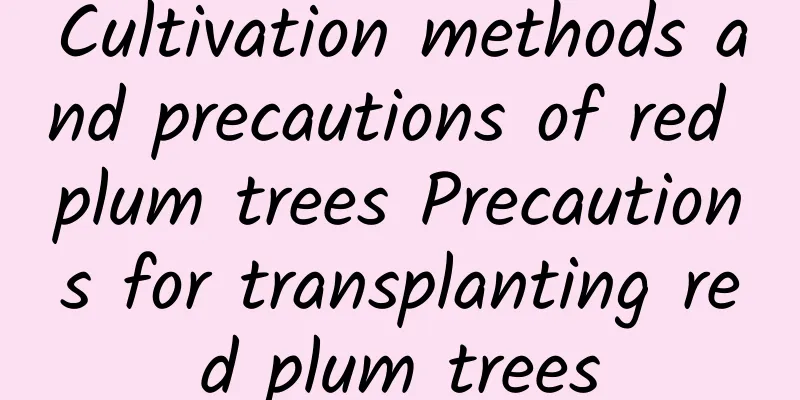Cultivation methods and precautions of red plum trees Precautions for transplanting red plum trees

|
The red plum tree is relatively easy to maintain. The red plum tree has a relatively low demand for water. During maintenance, if watering is too frequent, it will cause excessive water accumulation, causing the red plum tree to lose vitality and die. It can be watered once every 7 days. How to grow red plum trees1. Pot soil When caring for the plants, you need to use soil with good air permeability and drainage capabilities . It is best to change the soil after 1-2 years of cultivation and ensure the integrity of the soil structure. 2. Watering The red plum tree is relatively drought-resistant and has a relatively low demand for water. During normal care, it does not require a lot of watering, just keep the soil moist . 3. Lighting The red plum tree must be protected from direct sunlight during its growth process, especially in the scorching sun in summer. Direct sunlight will burn the leaves of the red plum tree, so proper shading is needed. 4. Fertilization The red plum tree has a relatively large demand for nutrients during its growth period. Fertilizer can be applied once every 14 days , but high concentrations should not be applied. Red plum tree maintenance precautionsWhen caring for red plum trees, pay attention to ventilation , otherwise they are more susceptible to diseases and pests, and ensure proper ventilation. Because red plum trees are very susceptible to powdery mildew in a high temperature and unventilated environment, if unfortunately infected, the diseased leaves and branches should be cleaned up in time to prevent secondary infection. Precautions for transplanting red plum trees1. Root disinfection When transplanting plum blossoms, the roots need to be soaked in potassium permanganate solution for 30 minutes before being taken out, which can disinfect and sterilize them. Alternatively, the roots can be soaked in a solution of carbendazim diluted with water , which can also achieve the effect of disinfection and sterilization. 2. Pot soil selection Precautions for transplanting plum blossoms: Coarse sand or gravel needs to be placed at the bottom of the flowerpot to increase ventilation and drainage capabilities. The soil for cultivation can be garden soil or humus soil . Adding some animal manure to the soil is very long-lasting and weak fertilizer, which can supplement nutrients. 3. Water the roots After transplanting, the soil needs to be fully watered , and then placed in a cool environment. No watering is required for a short period of time. After the seedling period is over , when the soil becomes dry, water it for the second time, and then resume the frequency of watering . 4. Avoid fertilizing Do not fertilize during the period of seedling acclimatization , as the nutrients in the soil are sufficient for the growth of plum blossoms. Otherwise, plum blossoms are prone to fertilizer damage. When new buds grow, apply a certain amount of thin fertilizer and bury it near the roots. Fertilization does not need to be too frequent, once a month is enough. 5. Transplanting in spring and autumn When transplanting, you need to choose a suitable season and climate to increase the chance of survival. Transplanting can be done in spring and autumn . When transplanting in summer, avoid high temperatures and strong light. The temperature in winter is too cold. If the roots are easily frostbitten after transplanting, avoid transplanting in winter. |
<<: How to cultivate and take care of purple pearls?
>>: How to grow gloxinia hibiscus and precautions How to grow gloxinia
Recommend
What are the benefits and consequences of watering flowers with red wine? The correct way to water flowers with red wine
Benefits of watering flowers with red wine Red wi...
How to propagate sunflowers
There are some things to note about the cutting p...
How to cultivate twig flower
Growing conditions of twig flower The branch flow...
How to prune calla lilies
1. High requirements for pruning It has relativel...
Difference between hairy radish and mountain radish
1. Leaf Difference The leaves of the hairy radish...
Corn seedling raising technology and methods
Corn is an important food crop in China and has a...
What are the cultivation methods and precautions of Mandarin Duck Jasmine?
Growth habits of jasmine Mandarin duck jasmine is...
Can I put the forget-me-not in my bedroom?
1. Is it possible? The answer is yes. Some friend...
What to do if the leaves of the firecracker flower turn yellow
1. Too much water When caring for plants, althoug...
How to increase the acidity of soil (how to make the soil acidic)
Acidic Soil Introduction Soil can be divided into...
What are the breeding methods and precautions of Xianrenshan
Growth habits of Xianrenshan Xianrenshan belongs ...
How to prune rubber trees? Methods and diagrams of pruning branches and leaves
Rubber tree pruning time Rubber trees need to be ...
Diseases and pests of cinnabar root (weed seeds) and their control
Diseases and prevention of cinnabar root Root-kno...
Don't mistake Amaryllis for Agapanthus
Introduction to Agapanthus Agapanthus africanus, ...
What are the cultivation methods and precautions of palm orchids?
Cultivation method of palm orchid The palm orchid...









